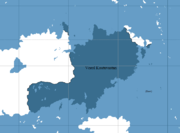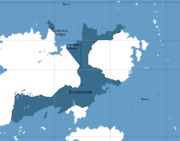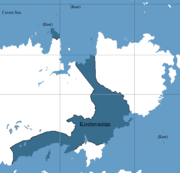Difference between revisions of "Salovia"
Tuvaltastan (Talk | contribs) (→Modern Salovia (1814-1985)) |
Tuvaltastan (Talk | contribs) (→Kostuv Interregnum (1214-1352)) |
||
| Line 78: | Line 78: | ||
Beatrice Quralanov, although not the first Queen of Salovia, was by far the most influential and successful. Quralanov removed many taxes instated during her father's reign, and grew the economy by establishing trade routes with neigboring Ethalria, Dragonia, Xagrurg, Oceansend, and Staynes. With no heir, and with no other family member willing to take the throne, Beatrice adopted a son, Ivan, who became the root of the rest of the Salov Royal Family tree. However, because Ivan did not have royal blood, he chose to marry Xenala II, a monarch from the fledgling kingdom of Nilovia whose bloodline, like the Salov Royal Family, traces back to Rorik Slovinovich. | Beatrice Quralanov, although not the first Queen of Salovia, was by far the most influential and successful. Quralanov removed many taxes instated during her father's reign, and grew the economy by establishing trade routes with neigboring Ethalria, Dragonia, Xagrurg, Oceansend, and Staynes. With no heir, and with no other family member willing to take the throne, Beatrice adopted a son, Ivan, who became the root of the rest of the Salov Royal Family tree. However, because Ivan did not have royal blood, he chose to marry Xenala II, a monarch from the fledgling kingdom of Nilovia whose bloodline, like the Salov Royal Family, traces back to Rorik Slovinovich. | ||
| − | === | + | ===Salovian Interregnum (1214-1352)=== |
''(Main Article: [[Kostuv Interregnum]])'' | ''(Main Article: [[Kostuv Interregnum]])'' | ||
Revision as of 16:59, 2 March 2019
| The Grand Monarchy of Salovia and Her Territories,
then The Grand Republic of Salovia Cstv'hstah
| |||||
|---|---|---|---|---|---|
|
|||||
|
|||||
| Capital | Port Barnaul, later Chita, then Novosibirsk | ||||
| Largest city | Port Barnaul, later Novosibirsk, then Tarov | ||||
| Demonym | Salovian, Salov | ||||
| Government | Absolute monarchy, later democracy | ||||
| Currency | Sinar, later the Salov Credit | ||||
HISTORY RECONSTRUCTION IS IN PROGRESS; INFORMATION ON THIS PAGE IS NOT ENTIRELY ACCURATE
Salovia was a nation that stretched throughout the middle of Aurora, and was separated after its civil war. It bordered the countries Caltharus and Ethalria. The nation was replaced by the nations Tuvaltastan, Tivot, Kostromastan, Imperial Fandom, and Baykalia, and is the successor to the Kostuvian Empire.
Contents
History
Dynastic Salovia (12-1894)
Slovin Dynasty (12-396)
(Main Article: Early Salovia)
Prior to the founding of Salovia, the geographic Salovia was filled with small kingdoms and citystates. Rorik von Slovinich was born a royal in the citystate Surol. Upon taking up the lead position of Noble of Surol, Slovinich declared himself the first king of a new empire. The Nobility of Surol became The Grand Monarchy of Salovia. Through raids and marriages, Salovia gradually established itself as a small nation, much larger than Surol, and a cultural divide soon developed: The high class inhabitants of Kristoa, now modern-day Chita, and the farming peasants that lived in the rest of the nation. The Kristoans were typically appointed by the king to high-ranking positions, and kept much of the wealth away from the rest of the country. A major example of the divide between noble and peasant was the infrastructure within the territory. The infrastructure, which included the first mailing system and a series of roadways, only serviced Kristoa and the immediate surrounding area, leaving the rest of the nation lacking in infrastructure. The Slovin Dynasty was predominantly defined by its struggles and skirmishes with neighboring tribes and kingdoms to keep its sovereignty.
Loktol Dynasty (396-827)
Jeoffery Loktolovich, formerly known as Jeoffery Slovinich, was the son of King Rorik IV. (Need to add reason for new dynasty) The Loktol Dynasty had a very similar industrious nature to the Slovin Dynasty. The Loktol Dynasty continued the expansion of Salovia, as did his predecessors before him. The first Queen of Salovia also came to power during this Dynasty, known as Tanya Loktolovich. Her reign was filled with scandal, with Tanya having been in three affairs while married to her husband, two of those affairs occurring at the same time. Tanya Loktolovich birthed a total of 14 children, all but one were illegitimate for the throne, being Rorik Loktolovich, later Rorik Lewinski.
Lewin Dynasty (827-895)
(Main Article: Lewin Dynasty)
Rorik Lewinski was the only king in this dynasty, and is arguably the most unpopular monarch in Salovian history. Lewinski exploited his kingdom through taxes and became the richest Salov King ever, with a wealth of $130,000,000,000 in ISD. This hoarding of wealth and gluttony resulted in the nation suffering from a further defined class divide between the king and his subjects than was already present, most notably effecting Salov nobility. The people of Salovia as a result revolted against the king, and executed Lewinski by beheading via Rotary Guillotine, along with his three sons, leaving Lewinki's populist daughter the throne. Lewinski was executed at the age of 106, making him the oldest monarch in Salovia.
Qurala Dynasty (895-1214)
(Main article: Qurala Dynasty)
Beatrice Quralanov, although not the first Queen of Salovia, was by far the most influential and successful. Quralanov removed many taxes instated during her father's reign, and grew the economy by establishing trade routes with neigboring Ethalria, Dragonia, Xagrurg, Oceansend, and Staynes. With no heir, and with no other family member willing to take the throne, Beatrice adopted a son, Ivan, who became the root of the rest of the Salov Royal Family tree. However, because Ivan did not have royal blood, he chose to marry Xenala II, a monarch from the fledgling kingdom of Nilovia whose bloodline, like the Salov Royal Family, traces back to Rorik Slovinovich.
Salovian Interregnum (1214-1352)
(Main Article: Kostuv Interregnum)
This era consisted of many incompetant and lame-duck monarchs who, for around a century, neglected the welfare of the monarchy and instead luxuriated in their immense wealth accumulated by Rorik Lewinski, which led to an eventual collapse of the nation in 1330 upon the succession of King Ivanolov Quralanov III. Ivanolov's twin brother Ivanovich Quralanov II, in an act of jealousy, declared himself the true King of Salovia. This battle for dominance completely split the empire into the northern Rukin dynasty and the southern Alvonic dynasty, resulting in the central plains separating for a time from Salovia, forming the first instance of what would become Kostromastan, and the area around Lake Nilovi gaining independence, forming the first long-term iteration of Nilovia. It took another century and a half to restore relations with the neighboring states, and to reunite the monarchy back together.
Molgov Dynasty (1352-1786)
(Main Article: Molgov Dynasty)
The Molgov Dynasty is the longest-running dynasty in Kostuv history. Taking the economic policies of the Qurala Dynasty, and the industriousness of the Loktol and Slovin dynasties, the Molgov Dynasty improved every aspect of the Salov way of life. These centuries of prosperity eventually led to the invention of the Auralgraph and the steam engine in later years. During the end of this dynasty, Codexian settlers began settling in the area east of the empire, which would later evolve into the nation of Xiopothos.
Vorolov Dynasty (1786-1792)
Similar to the Lewin Dynasty, the Vorolov Dynasty only had a single monarch, named Rorin Vorolov. Known as Rorin the Terror, Vorolov's army killed millions, however the exact number is unknown. Estimates range from as little as 2,000,000 to as much as 15,000,000. Regardless, Vorolov and his army attempted to conquer the whole of Aurora, and succeeded in taking most of the territory east of the Morstaybishlian Mountains, with exception to the Codex colony as well as Ethalria and Xagrurg. The last legitimate monarch of Salovia, Rorin Vorolov had only one son with a mistress, named Lurin Vorolov I, who would inherit the riches of his father.
Era of Uncertainty (1792-1814)
(Main article: Kostuv Revolutionary Era)
The Era of Uncertainty was a period wherein the people of Salovia began experimenting with different governmental systems, eventually deciding upon a system inspired by the Xagrurgian governmental system and the Codexian Colony's governing system. During this era of civil unrest, the Baykalian people attempted and succeeded to secede from Salovia, taking advantage of the pandemonium. They managed to secede, and Caltharus and Salovia both actively looked into to annexing the territory soon after. When Baykalia suffered extreme poverty for five years, known in Baykalia as the Age of Fatigue, Baykalia struck a deal with Salovia in which the territory would be annexed by Salovia, but it would require Baykalia to have a much larger say in the nation than the rest of Salovia. The Codexian empire had also been gradually pushing Kostuvians out of eastern Aurora during this era, slowly taking large chunks of land at a time through various methods, including land purchases, and a short-lived war between Codex and Salovia over the area just east of modern-day Tuvaltastan.
Modern Salovia (1814-1985)
(Main article: Post-Monarchy Salovia)
After the Era of Uncertainty came to a close, the people of Salovia slowly developed a leadership that they were comfortable with, known as the Grand Republic of Salovia. The first Chancellor of this new republic was Mikhail Karanovich, who would go down in history as the greatest and most influential leader of Salovia, having united the diverse peoples and polities of the nation, and succeeding in repairing the infrastructure and economy, as well as the public's faith in their leadership. During this era, Salovia began its first and only colonial conquest into the territory of what would become Lapimuhyo. The Grand Republic would continue to exist as the internationally-recognized government until the Salovian Civil War in 1985.
Decline of Salovia
Salov Participation in The Auroran Imperial War
From the beginning to the middle of the 1970's, Salovia was on the Empirical side of The Auroran Imperial War, and spent much of its participation attacking and defending the western and southern borders of the nation. Prior to the conflict, Imperial Fandom had successfully acquired independence shortly before the war, and joined the Allies.
Salov Civil War
The Salov Civil War was by far the most devastating war in Salov history, and arguably one of the deadliest in Urth's history. Killing around 60 million people through both direct and indirect means, the war resulted from a growing resentment by Kostroms and Tuvalts towards the Baykalians, who gained a disproportionate representation, a direct result of the Baykalian Annexation. Baykalians had held the majority in both the upper and lower houses of legislature since 1952, and systematically passed legislature that would slowly maximize Baykalian influence and minimize Kostrom and Tuvalt influence in elections and in legislature. With numerous protests, both peaceful and violent, occurring within the decade before the war, the misrepresented majorities of Kostroms and Tuvalts revolted against the Baykalians, officially starting the war in 1985. It would be another two decades, and numerous battles, airstrikes, and deaths until the war would officially end in 2005 with the signing of the Treaty of Astrakhan.
Economy
Thanks to the diverse geography and relatively large size of the nation for most of its life, Salovia was a major regional power, with a notable economic global influence, due to its position between Gondwana and Yasteria. With a geographic position at the entrance to Aurora from the Pacific allowed for the nation to prosper, especially under the Qurala and Molgov Dynasties, and the Imperial Era. From the port city of Tarov to the industrial centers of Chita, Shagonar, and Novokuznetsk, Salovia was set to become a powerhouse economy. The Civil War and the recent Tivotian independence, however, hindered the nation to such an extent that the nation's influence in the world drastically fell. Tivot, due to it gaining independence shortly after the Auroran Imperial War, maintained the prosperity of former Salovia, itself becoming a major financial hub.
Culture
Tivot
Tivot, although having been a part of Salovia since 847 AD, was always culturally and geographically separate from the rest of the nation. This separation from the mainland resulted in other cultures having a heavy influence in the way Tivotians lived their lives. Nations like Caltharus, Staynes, East Malaysia, and FPS all had cultural additions to combine into the Tivotian culture. This ended up fueling Tivot's independence movement in 1975. Very business-focused, a number of prominent Tivotians have developed the mindset of "succeed for the betterment of Tivot" and put the nation first.
Northern Baykalia
Separated from the rest of Salovia via the Kalivian Mountains, northern Baykalia developed a culture distinct from the rest of the nation. Farming-focused, Baykalians value collectivism over individualism, and value the family above all. Religion plays a large part in this region, with North Kotvarianism being the dominant religion. In recent years, the Posol Family has worked to replace Kotvarianism with their own state-sponsored religion wherein the Posols are the center.
The Central Desert
Southern Baykalia, the vast majority of Kostromastan, and Northern Tuvaltastan make up this largest section of Salovia. All within the Great Auroran Desert, these regions have many festivals to celebrate the Salov river, the bloodline of most of the Great Auroran Desert. These festivals stem from Ancient Salovian traditions, and have stood the test of time.
Southern Tuvaltastan
Taking a very "every man for himself" ideology, Tuvaltastan is a culture focused on the concept that success will make one happy. Parents are known to kick their children out of the house after their eighteenth birthday, a practice that many experts believe is a driving factor of anxiety and stress in younger ages.






